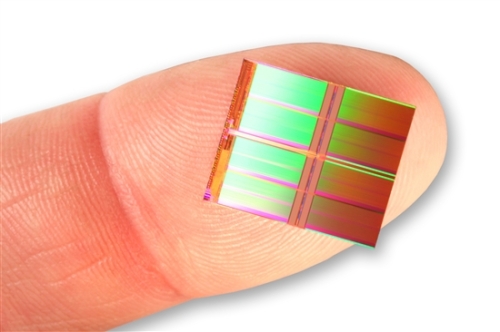 In April of this year, Intel and Micron's flash memory technology partner, IMFT, released the world’s first 64Gb (8GB) MLC NAND flash memory based on the 20nm process technology. The two currently-produced SSDs, such as Intel's mid-to-high-end 510 series, or the most popular Micron C400/Crucial M4 currently on the market, all use 25-nm process flash chips.
In April of this year, Intel and Micron's flash memory technology partner, IMFT, released the world’s first 64Gb (8GB) MLC NAND flash memory based on the 20nm process technology. The two currently-produced SSDs, such as Intel's mid-to-high-end 510 series, or the most popular Micron C400/Crucial M4 currently on the market, all use 25-nm process flash chips. The transition to 20nm of NAND flash memory can achieve a die size and a gradual reduction in cost. The same 64Gb 2bit/cell MLC NAND flash memory based on IMFT's 25nm process has a die size of 167mm2, while the 20nm process using IMFT can be further reduced to 118mm2. Although the initial adoption of a new process may result in some cost increases, over time the same capacity chips will eventually be cheaper than before.
Today, Intel and Micron officially announced a second-generation NAND flash memory chip based on 20nm process technology, with a capacity of 128Gb (16GB). Compared with the previous 64Gb products, the new chip is not only doubled in capacity, but also the SSD's internal connection interface (that is, the interface between the SSD master and NAND flash memory) has been changed to ONFi 3, compared with the previous generation and 25nm. ONFi 2 used by craft products. X transmission bandwidth has also been expanded a lot. ONFi 2 of the IMFT 25nm product. x is limited to 166 MT/s, and 64Gb 20 nm particles are 200 MT/s. The internal single-channel transmission speed of the new product is 300 MT/s. The main advantage of the new interface is that it can significantly increase the continuous reading speed.
Not only has the internal transfer interface been upgraded, but the page size of the new product has also improved: some older products have 4KB, 64Gb 20nm increased to 8KB, and today's 128Gb 20nm MLC flash memory has reached 16KB. Due to large changes in the internal transfer interface and page size, it is expected that SSDs using this new flash memory chip will not be available within 1-1.5 years. In addition to the need to develop masters and firmware that support larger page sizes, the new die size is about twice that of the 64Gb model released in April, and the factory will need time to further increase yields and reduce costs.
Intel and Micron said that 20nm 128Gb flash memory will begin mass production in the second quarter of 2012, and it is expected to be used on SSD by 2013. By then, SSD will truly enter the terabyte era. Manufacturers will be able to create 128GB SSDs in fingertip-sized single-chip packages (8 such 128Gb NAND flash stacks), can make 1TB SSD with only 8 packaged chips, if the chip is covered with 2.5-inch PCB on both sides of the total 16, the capacity can reach 2TB. Ultrabook/MacBook Air with this kind of flash memory can easily reach 512GB/1TB capacity.
In addition to the release of new 128Gb flash memory, Intel and Micron also announced the official mass production of 64Gb 20nm NAND. However, due to the need to develop master controls for 8KB page size as well, SSD products with 64Gb flash memory are expected to be seen in mid-2012.
But at the same time it is also accompanied by doubts - durability, Intel and Micron have not yet revealed whether the number of writes is attenuated. IMFT's 20nm consumer flash design life is 3000-5000 write cycles. The new flash memory uses the HKMG process and a redesigned structure, or it can reduce the number of transistors while ensuring its lifetime.
In short, it can be expected that with the gradual popularization of new 20nm flash memory, the cost of SSDs that are currently approaching 1 US$/GB will likely fall below this threshold next year.
Stick Blender is Hand Blender that easy to operate, with high quality, original and novel design, there has AC motor and DC motor version, injection ABS material body, plastic or stainless steel blender shaft, or any painting color is available, it has many accesorries as measuring cup, blender shaft, whisk, different size Chopper with one blade or two blade, wall mount, slicer, ice crusher, speed selector, cable storage etc for various food, as cake, biscuit, cream, milk shake, juice, meat, vegetable slice, paste etc., It got GS/CB/CE/EMC/LVD/ROHS/Erp/LFGB/RAACH safety certificate with competitive price
Stick Blender
Stick Blender,Electric Stick Blender,Fruit Mini Stick Blender,Powerful Blender
Jiangmen Oudisi Electric Co., Ltd. , http://www.oudisi-electric.com
